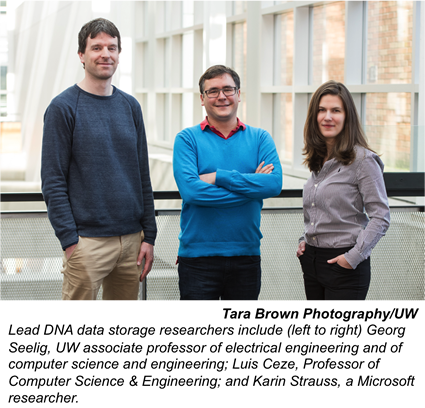 Imagine storing pictures, videos and documents in synthetic DNA molecules. That day is likely not far way, thanks to a team of UW and Microsoft researchers who have developed a new method for storing data in synthetic DNA, which addresses the critical need for long-term data storage.
Imagine storing pictures, videos and documents in synthetic DNA molecules. That day is likely not far way, thanks to a team of UW and Microsoft researchers who have developed a new method for storing data in synthetic DNA, which addresses the critical need for long-term data storage.
The research team, which includes electrical engineering and computer science & engineering Associate Professor Georg Seelig, has tackled several of the outstanding key issues for making DNA storage practical. The research was undertaken by researchers in the Molecular Information Systems Lab housed in the UW Electrical Engineering Building, in close collaboration with Microsoft Research. Co-authors include Luis Ceze, UW associate professor of computer science and engineering.
DNA molecules can store information several million times more densely than existing digital storage methods, from flash drives to hard drives. Available storage capacity is not only unable to keep up with demand, but current storage mediums are only reliable for up to 30 years.
 To address the error rate of DNA synthesis and sequencing, the researchers invented a new encoding scheme that allows data to be more reliably extracted. Another obstacle is efficiently reading data in DNA-based storage. Currently, to read a single byte that is in storage requires the entire DNA pool to be sequenced and decoded. To allow access to specific pieces of data, the researchers developed a new method to amplify only the desired information so that the sequencing is biased toward the data. The result is faster, more efficient retrieval.
To address the error rate of DNA synthesis and sequencing, the researchers invented a new encoding scheme that allows data to be more reliably extracted. Another obstacle is efficiently reading data in DNA-based storage. Currently, to read a single byte that is in storage requires the entire DNA pool to be sequenced and decoded. To allow access to specific pieces of data, the researchers developed a new method to amplify only the desired information so that the sequencing is biased toward the data. The result is faster, more efficient retrieval.
The researchers recently presented their paper at the ACM International Conference on Architectural Support for Programming Languages and Operating Systems.
See Also:

